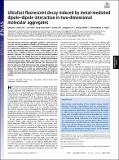| dc.contributor.author | Xiao, Jun | |
| dc.contributor.author | Liu, Xiaoze | |
| dc.contributor.author | Liu, Yongmin | |
| dc.contributor.author | Zhang, Xiang | |
| dc.contributor.author | Hu, Qing | |
| dc.contributor.author | Jin, Dafei | |
| dc.contributor.author | Nam, Sang Hoon | |
| dc.contributor.author | Fang, Xuanlai | |
| dc.date.accessioned | 2018-04-24T14:58:56Z | |
| dc.date.available | 2018-04-24T14:58:56Z | |
| dc.date.issued | 2017-09 | |
| dc.date.submitted | 2017-02 | |
| dc.identifier.issn | 0027-8424 | |
| dc.identifier.issn | 1091-6490 | |
| dc.identifier.uri | http://hdl.handle.net/1721.1/114927 | |
| dc.description.abstract | Two-dimensional molecular aggregate (2DMA), a thin sheet of strongly interacting dipole molecules self-assembled at close distance on an ordered lattice, is a fascinating fluorescent material. It is distinctively different from the conventional (single or colloidal) dye molecules and quantum dots. In this paper, we verify that when a 2DMA is placed at a nanometric distance from a metallic substrate, the strong and coherent interaction between the dipoles inside the 2DMA dominates its fluorescent decay at a picosecond timescale. Our streak-camera lifetime measurement and interacting lattice–dipole calculation reveal that the metal-mediated dipole–dipole interaction shortens the fluorescent lifetime to about one-half and increases the energy dissipation rate by 10 times that expected from the noninteracting single-dipole picture. Our finding can enrich our understanding of nanoscale energy transfer in molecular excitonic systems and may designate a unique direction for developing fast and efficient optoelectronic devices. Keywords: molecular aggregate; fluorescence; nonradiative decay; dipole–dipole interaction; surface plasmon | en_US |
| dc.description.sponsorship | National Science Foundation (U.S.) (Grant CMMI-1120724) | en_US |
| dc.description.sponsorship | United States. Air Force Office of Scientific Research (Award FA9550-12-1-0488) | en_US |
| dc.publisher | National Academy of Sciences (U.S.) | en_US |
| dc.relation.isversionof | http://dx.doi.org/10.1073/PNAS.1703000114 | en_US |
| dc.rights | Article is made available in accordance with the publisher's policy and may be subject to US copyright law. Please refer to the publisher's site for terms of use. | en_US |
| dc.source | National Academy of Sciences | en_US |
| dc.title | Ultrafast fluorescent decay induced by metal-mediated dipole–dipole interaction in two-dimensional molecular aggregates | en_US |
| dc.type | Article | en_US |
| dc.identifier.citation | Hu, Qing et al. “Ultrafast Fluorescent Decay Induced by Metal-Mediated Dipole–dipole Interaction in Two-Dimensional Molecular Aggregates.” Proceedings of the National Academy of Sciences 114, 38 (September 2017): 10017–10022 © 2017 National Academy of Sciences | en_US |
| dc.contributor.department | Massachusetts Institute of Technology. Department of Mechanical Engineering | en_US |
| dc.contributor.mitauthor | Hu, Qing | |
| dc.contributor.mitauthor | Jin, Dafei | |
| dc.contributor.mitauthor | Nam, Sang Hoon | |
| dc.contributor.mitauthor | Fang, Xuanlai | |
| dc.relation.journal | Proceedings of the National Academy of Sciences | en_US |
| dc.eprint.version | Final published version | en_US |
| dc.type.uri | http://purl.org/eprint/type/ConferencePaper | en_US |
| eprint.status | http://purl.org/eprint/status/NonPeerReviewed | en_US |
| dc.date.updated | 2018-04-20T16:49:01Z | |
| dspace.orderedauthors | Hu, Qing; Jin, Dafei; Xiao, Jun; Nam, Sang Hoon; Liu, Xiaoze; Liu, Yongmin; Zhang, Xiang; Fang, Nicholas X. | en_US |
| dspace.embargo.terms | N | en_US |
| dc.identifier.orcid | https://orcid.org/0000-0003-4398-0662 | |
| dc.identifier.orcid | https://orcid.org/0000-0002-9813-2401 | |
| dc.identifier.orcid | https://orcid.org/0000-0002-2065-7267 | |
| dc.identifier.orcid | https://orcid.org/0000-0001-5713-629X | |
| mit.license | PUBLISHER_POLICY | en_US |
